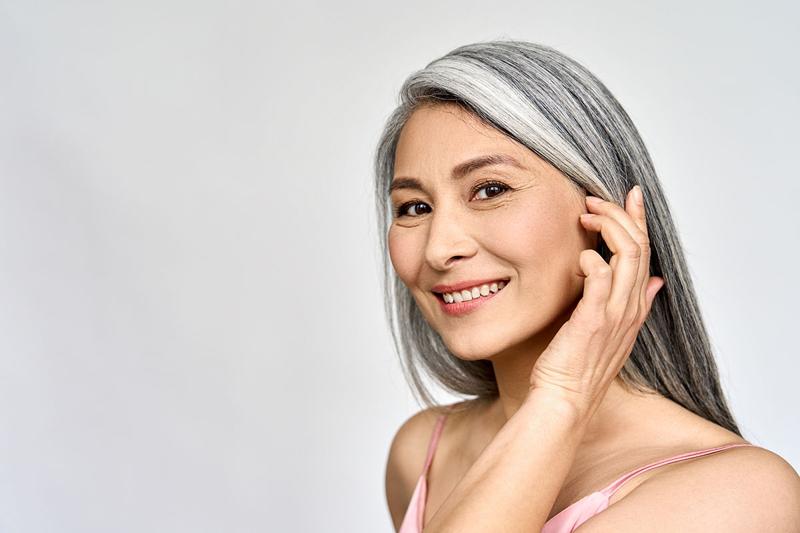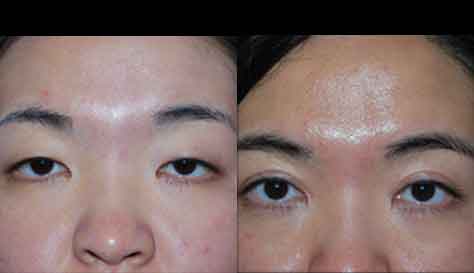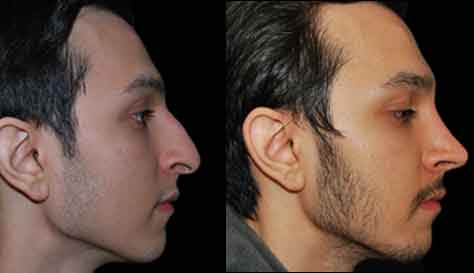Asian Rhinoplasty
Conveniently located to serve the areas of New Jersey and New York
Dr. Ovchinsky is a nationally recognized expert in Rhinoplasty. For more information about this procedure please view our Rhinoplasty page.

Asian rhinoplasty is a specialized form of nasal surgery designed to enhance the aesthetics of the nose while considering the unique anatomical and cultural features of individuals of Asian descent. (1) It focuses on factors that contribute to a nose that is shorter and flatter than the patient would like. The shape of the nostrils can also be addressed. Asian nose surgery can differ from other kinds of rhinoplasties as the nose is often augmented, or built up, rather than shaved down. (1) Quite frequently, patients present with foreshortened noses requiring nasal lengthening. To carry out this augmentation, plastic surgeons can use various techniques to create an optimal nasal profile according to the patient’s wishes.
At Plastic Surgery of Short Hills, Dr. Alexander Ovchinsky is a facial plastic surgeon with double board-certification. With office locations in both New Jersey and New York, Dr. Ovchinsky delivers top-tier service and personalized treatments with specialization in rhinoplasty and facial procedures.
If you are considering rhinoplasty, schedule a personal consultation at either one of our offices:
- Short Hills, NJ: (973) 379-0101
- Brooklyn, NY: (718) 646-1234
You can also request an appointment by filling out our contact form.
Contents
About Rhinoplasty
Rhinoplasty is rightfully considered to be one of the most complex cosmetic surgeries, and it is essential for an individual to choose an experienced and highly trained facial plastic and reconstructive surgeon for Asian rhinoplasty. Dr. Ovchinsky makes it a priority to take the time to learn about an individual’s goals and provide him or her with a natural-looking and ethnically appropriate nose.
What Makes Asian Rhinoplasty Different?
During an Asian rhinoplasty, Dr. Ovchinsky can increase the height of the dorsum, improve the projection and definition of the nasal tip and lengthen the nose with several different methods. He can use Gore-Tex dorsal implant or cartilage graft for dorsal augmentation. (1) Increasing dorsal height will create the illusion of narrowing the width of the front of the nose. (2) This technique frequently eliminates the need for osteotomies, which is when Dr. Ovchinsky fractures and mobilizes the bones of the nose. To refine the tip of the nose, Dr. Ovchinsky can modify the tip cartilages to decrease tip roundness and make tip better defined. Conservative cartilage narrowing may be necessary in certain cases, and judicious use of tip grafts can provide the tip with better support and better definition.
Benefits of Rhinoplasty
A rhinoplasty can help patients achieve their preferred nasal appearance and functionality. It can offer the following benefits:
- Facial balance: Because of the nose’s central location, a rhinoplasty can help provide balance and complement the other facial features.
- Nasal function: If a patient experiences breathing problems caused by a deviated septum or other obstructions, Dr. Ovchinsky can address functional issues.
- Natural look: Dr. Ovchinsky will take great care to construct the nose in a way that is both flattering and fitting for the patient’s face.
- Confidence: When patients are more satisfied with the appearance of their nose, they may feel more confident in their facial appearance.
- Personalized treatment: Dr. Ovchinsky understands that each patient’s unique face requires a personalized procedure that aligns with their goals.
Asian rhinoplasty focuses on refining the nose while preserving the patient’s ethnic identity. Each person’s face has its own characteristics, creating a need for a tailored approach. The successful outcome of a rhinoplasty depends upon understanding the nuances of anatomical differences and ensuring that any changes considered improve the facial contour without compromising the patient’s uniqueness.
Candidates
If you are currently dissatisfied with your nose’s appearance, rhinoplasty may be right for you. The ideal candidate for Asian rhinoplasty is:
- Of Asian descent or has features that can be addressed with an Asian rhinoplasty
- In good overall health
- Aware of realistic expectations (2)
Personal Consultation
At your personal consultation, Dr. Ovchinksy will examine your nose and its features in relation to the rest of your face. We understand that every patient has an ideal nose in mind, so we will ask you to explain your goals during this meeting, and bring any images that will aid us in planning your procedure. After this initial evaluation period, Dr. Ovchinsky will create a personalized treatment plan in line with your goals and functional requests.
To schedule a personal consultation at either our New Jersey or New York office, fill out a contact form or give us a call:
- Short Hills, NJ: (973) 379-0101
- Brooklyn, NY: (718) 646-1234
We look forward to talking with you helping you achieve your facial goals.
Preparation

There are certain steps Dr. Ovchinsky will recommend you take in order to prepare for your Asian rhinoplasty procedure. For example, if you are on any blood thinning medications or supplements, he will ask you to stop them approximately 1 week prior to surgery. You should avoid certain over-the-counter medications or adjust your current medications as directed. You may continue taking most routine medications up until the morning of surgery with small sips of water. Also, you will have to completely quit smoking in the weeks before surgery and for the duration of your recovery. If you have any questions or concerns during your preparation, you can call our office so our knowledgeable team can provide personalized guidance.
Procedure
The specific details of your Asian rhinoplasty treatment plan will depend on the surgical techniques that best fit your nose and facial structure. These may include:
- Nasal Bridge Augmentation: This involves elevating and enhancing the height of the nasal bridge, using materials such as nasal implants or cartilage from other body parts, primarily rib.
- Tip Refinement: Often known as “tip plasty,” this method focuses on contouring the nasal tip to give it an aesthetically pleasing appearance based on the patient’s features.
- Alar Base Reduction: This technique reduces the width of the nostrils for better proportion relative to the rest of the facial features, enhancing overall aesthetics.
The length of the procedure will vary depending on these factors, but Asian rhinoplasties usually take around 2-3 hours. The nose will be carefully shaped according to your unique treatment plan, and Dr. Ovchinsky will close the incisions in discrete locations.
Should you require nasal augmentation, a range of different implant types are available, which provide results tailored to each individual. At Plastic Surgery of Short Hills, we offer Gore-Tex and cartilage implants.
Gore-Tex Augmentation
Gore-Tex, which is made out of polytetrafluoroethylene, is a synthetic material with microphones that allows for soft tissue in growth and better implant integration and stability. Dr. Ovchinsky will sculpt the Gore-Tex implant into a shape that is fitting for your unique nose.
Autogenous Augmentation
Autogenous augmentation typically uses a patient’s rib cartilage graft to augment the dorsum and provide better tip support and definition.
Recovery
After Dr. Ovchinsky closes the incisions and applies the proper bandaging, we will take you to the recovery room for a few hours until the effects of the anesthesia wear off. Once you are stable, a trusted individual will drive you home. We will recommend that you focus on resting and relaxing for the first few days after your surgery. During this resting period, you should keep your head elevated to help the swelling go down. Your energy and active abilities will slowly increase each day, but it will take up to 2 weeks before you start to feel like your old self again. You should avoid any strenuous activity or exercise for around 4 weeks. You will need to take the medication prescribed to you by Dr. Ovchinsky during this time, which usually includes antibiotics, pain medicine, antibiotic ointment for the incisions, and occasionally anti-nausea medications.
Patients can eat whatever they want during their recovery. However, we will recommend that you gradually advance your diet from liquids (fruit juice, milkshake, etc.) to soft food (pudding, macaroni and cheese, mashed potatoes and gravy, oatmeal, pasta) and finally to solids as tolerated. To prevent dehydration, please drink as much juice and nutritional fluid as possible. We will remove your stitches 5-6 days after your surgery during a follow-up visit.
Results
Immediately after your rhinoplasty, you may see a difference in the appearance of your nose. After the swelling goes down within the first 1-2 weeks, results will be even more pronounced. Rhinoplasty results will take anywhere from 6 to 12 months to become final because of the intricacies of the nasal anatomy.
Dr. Ovchinsky tailors his surgical technique to the individual patient rather than using the same run-of-the-mill surgery on everybody. The techniques he uses for Asian rhinoplasties produce natural-looking, long lasting results. The vast majority of patients are quite surprised afterward at how little discomfort they have and how quickly they return to normal activity after their procedure. Most patients have minimal bruising, and scars are typically minimal and are often difficult to see once they have fully matured.
Cost of Asian Rhinoplasty in New Jersey
The cost of your rhinoplasty will depend on the details of your treatment plan. Dr. Ovchinsky takes a unique approach to each Asian rhinoplasty, so in order to receive an accurate quote, you will need to come into one of our offices for an in-depth consultation.
To schedule an appointment at Plastic Surgery of Short Hills, fill out our contact form or call your nearest location.
- Short Hills, NJ: (973) 379-0101
- Brooklyn, NY: (718) 646-1234
References
- Lam SM. Asian Rhinoplasty. Seminars in Plastic Surgery. 2009;23(3):215-222. doi:https://doi.org/10.1055/s-0029-1224801
- Bergeron L, Chen PKT. Asian Rhinoplasty Techniques. Seminars in Plastic Surgery. 2009;23(1):16-21. doi:https://doi.org/10.1055/s-0028-1110097





